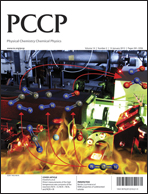Periodic calculations of excited state properties for solids using a semiempirical approach
Abstract
The semiempirical SCF MO method MSINDO (modified symmetrically orthogonalized intermediate neglect of differential overlap) [T. Bredow and K. Jug, Electronic Encyclopedia of Computational Chemistry, 2004] is extended to the calculation of excited state properties through implementation of the configuration interaction singles (CIS) approach. MSINDO allows the calculation of periodic systems via the cyclic cluster model (CCM) [T. Bredow et al., J. Comput. Chem., 2001, 22, 89] which is a direct-space approach and therefore can be in principle combined with all molecular quantum-chemical techniques. The CIS equations are solved for a cluster with periodic boundary conditions using the Davidson–Liu iterative block diagonalization approach. As a proof-of-principle, MSINDO-CCM-CIS is applied for the calculation of optical


 Please wait while we load your content...
Please wait while we load your content...